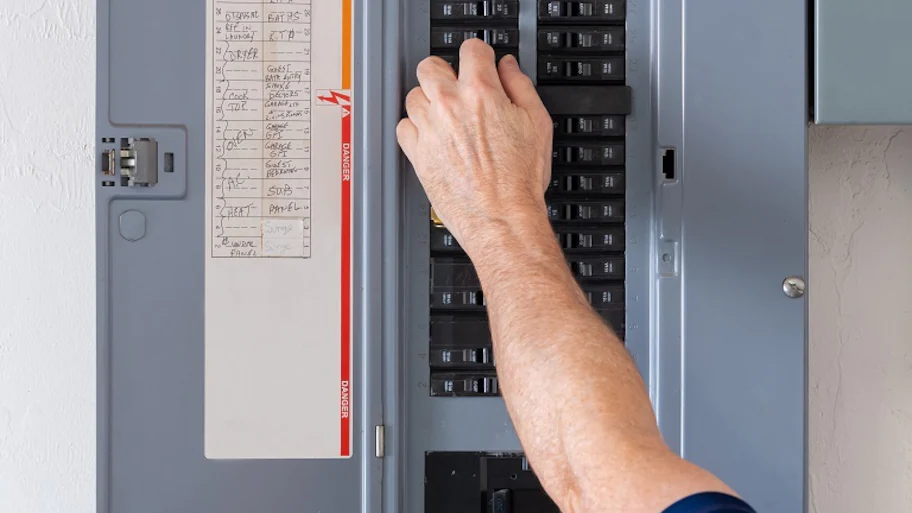In the modern realm of electrical systems, ensuring power distribution safety, efficiency, and reliability is paramount. As technology evolves, your electrical infrastructure may require transformation to meet the growing demands of our energy-intensive lives.
The load center is the vital component responsible for managing electrical distribution, acting as the nerve center controlling electricity flow throughout your space. In this exploration of electrical system upgrades, delve into the signs indicating the need for a load center upgrade, its benefits, and the overall enhancement it brings to your electrical network.
Table of Contents
When and Why You Should Upgrade Your Load Center
Upgrading your electrical load center, also known as a breaker panel or distribution board, is an essential consideration for homeowners and property owners. The load center is the hub where electricity enters your home or building and is distributed to various circuits. Here are some reasons when and why you should consider upgrading your load center:
Increased Electrical Demand
If you add more electrical appliances, devices, or circuits to your home, your current load center can’t handle the increased demand. This can lead to tripped breakers, frequent power outages, or even overheating issues. Upgrading to a higher capacity can accommodate your growing electrical needs.
Renovations or Home Additions
If you’re planning to remodel your home or add new rooms, you might need additional circuits to power new lighting, outlets, appliances, or HVAC systems. Upgrading it during renovations ensures that your electrical system can safely handle the new load without overloading.
Outdated Equipment
Older homes may have load centers with outdated technology and safety features. Its modern versions come with advanced circuit breakers that provide better protection against electrical faults, such as short circuits and overloads. Upgrading to a newer one with improved safety features can reduce the risk of electrical hazards.
Safety Concerns
If you’re experiencing issues like tripped breakers, flickering lights, buzzing sounds, or hot spots around your existing load center, these could be signs of electrical problems. Upgrading the load center can address these safety concerns, preventing potential fire hazards and electrical accidents.
Compliance with Electrical Codes
Electrical codes and regulations may change over time to reflect updated safety standards. Upgrading it can help ensure that your electrical system is current and in compliance with local rules if your current load center does not adhere to the most recent specifications.
Better Load Distribution
Upgrading to a larger one allows for better distribution of electrical loads across various circuits. This helps prevent overloading on individual circuits and reduces the risk of tripped breakers.
Increased Property Value
A modern and well-maintained electrical system, including an upgraded load center, can enhance the value of your property. It is an attractive feature for potential buyers who want an efficient and safe electrical system.
Insurance and Lender Requirements
Some insurance companies and lenders may require you to have an updated one as a condition for coverage or financing. This is often part of their risk assessment to protect the property against electrical hazards.
Signs That Signal the Need for a Load Center Upgrade
Recognizing the signs and understanding the importance of a load center upgrade is crucial for maintaining your home’s electrical system’s safety, efficiency, and functionality. Here are seven signs that show it might be time to make an upgrade:
- Frequent Circuit Breaker Tripping
Circuit breakers are designed to trip when there’s an overload or short circuit to prevent electrical damage and fires. If you experience frequent tripping, it is a sign that your current load center may not be able to handle your home’s electrical demand. This could be due to increased devices and appliances drawing power. Upgrading to a higher capacity load center allows for a smoother distribution of electricity, reducing the need for frequent breaker resets.
- Outdated System
Older versions of it might need more advanced safety features present in modern ones. These safety features include arc fault circuit interrupters (AFCIs) and ground fault circuit interrupters (GFCIs), which provide enhanced protection against electrical hazards. Outdated systems might also have deteriorated wiring and connections, increasing the risk of electrical problems. Upgrading to a newer load center not only improves safety but also ensures compliance with modern electrical standards.
- Flickering Lights and Electrical Issues
If your lights flicker, dim, or your appliances do not function properly, it could indicate an overloaded electrical system. This happens when too many devices are drawing power from a single circuit. An upgraded one allows for the creation of additional circuits, which means power can be more evenly distributed, addressing these issues and preventing further strain on the system.
- Buzzing Sounds or Heat
Unusual buzzing sounds or excessive heat emanating from it can signal problems such as loose connections, damaged components, or inadequate ventilation. These issues can lead to electrical fires or system failures. Upgrading your load center ensures that components are properly installed and that the system functions without generating excessive heat or abnormal noises.
- Adding New Appliances or Rooms
Whenever you are planning to add new appliances, rooms, or conduct a renovation, it’s an opportune time to consider an upgrade. These additions often increase the demand for electricity. An upgraded load center can accommodate the increased load without causing overloads or potential electrical hazards.
- Safety Concerns
Any visible signs of sparks, smoke, or burning smells around it should be treated as urgent safety concerns. These indicate serious electrical issues that could lead to fires, electrical shocks, or damage to your property. Upgrading your load center promptly addresses these hazards and ensures your home’s and its occupants’ safety.
- Meeting Modern Standards
Electrical codes and regulations evolve to incorporate the latest safety practices and technological advancements. If your load center does not meet current standards, it could pose risks to your home’s electrical system and its users. Upgrading brings your electrical system up to date, ensuring that it meets the latest requirements for safety and functionality.
Benefits of Upgrading Load Centers
Upgrading the load center offers a range of advantages that contribute to a safer, more efficient, and more accommodating electrical system for your home or property. Here are the benefits of upgrading your load center:
- Improved Electrical Safety
Upgrading it introduces modern safety features like arc fault circuit interrupters (AFCIs) and ground fault circuit interrupters (GFCIs). These technologies provide better protection against electrical faults, reducing the risk of fires, shocks, and other hazards. Enhanced safety measures can safeguard your property and the well-being of its occupants.
- Increased Capacity
An upgrade one allows you to accommodate higher electrical demands. With more circuits and a higher capacity, you can power additional appliances, devices, and equipment without overloading the system. This prevents frequent tripped breakers and ensures a stable power supply throughout your property.
- Enhanced Convenience
More circuits mean you can allocate power to specific areas or appliances, providing greater control and flexibility over your electrical usage. This improved distribution reduces the chances of power outages due to overloaded circuits, enhancing the convenience of daily activities.
- Support for Modern Living
As technology evolves, our homes rely on more electronic devices and appliances than ever before. Upgrading it enables you to adapt to this modern lifestyle by accommodating the increased power requirements of devices like smart home systems, electric vehicles, and energy-efficient appliances.
- Reduced Maintenance
Newer one often require less maintenance due to improved design and higher-quality components. This can lead to cost savings over time, as you’ll spend less on repairs and replacements compared to maintaining an older system.
- Property Value
An upgraded electrical system, including the load center, can enhance the value of your property. Potential buyers appreciate homes with updated, safe, and efficient electrical infrastructure. This can make your property more appealing and fetch a higher resale value.
- Compliance with Codes and Regulations
Electrical codes and regulations change over time to ensure safety and efficiency. Upgrading your load center ensures compliance with the latest standards, preventing potential legal issues and ensuring your property meets industry requirements.
- Long-Term Investment
While an upgrade may have an initial cost, it’s a long-term investment in your property’s safety, functionality, and value. The benefits gained from improved electrical safety, increased capacity, and convenience can outweigh the upfront expense.
Elevating Your Electrical Experience with Schneider
The load center upgrade is not just an electrical enhancement; it’s a commitment to progress, safety, and the seamless integration of technology into your daily life. By heeding the signs, embracing the benefits, and making a conscious choice, you elevate your electrical infrastructure from the mundane to the exceptional. The path is clear, and the benefits are manifold – the power is in your hands to unlock a brighter, safer, and more efficient future.
Seize the opportunity to enhance safety, increase capacity, and enjoy modern convenience by upgrading your load center. Make the proactive choice to invest in your property’s safety, efficiency, and value with Schneider Electric. Visit our website at www.se.com/th/th to discover the cutting-edge offerings we have in store. Also, explore our ComPact Molded Case Circuit Breakers, designed to protect cables from 100A to 3200A. With strong breaking capacities, they safeguard smaller cables near high-energy sources. With Schneider Electric, you’re not just upgrading – you’re embracing a commitment to excellence in electrical technology.











